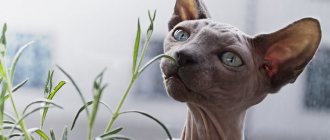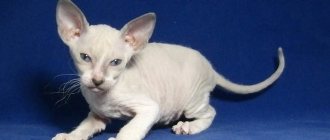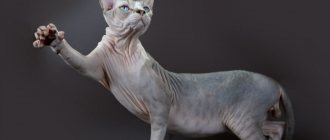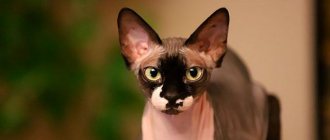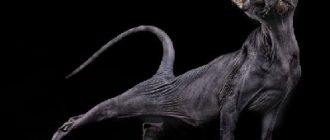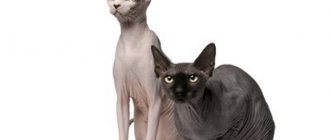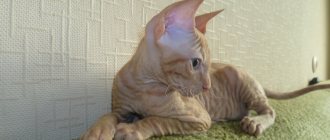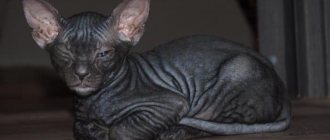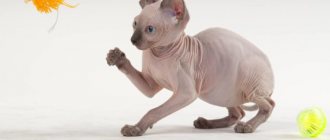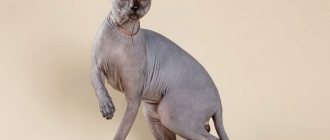| Origin | Russia |
| Wool | absent |
| Dimensions | 3-5 kg. |
| Lifespan | 12-14 years old. |
Exotic cat breeds are finding more and more connoisseurs due to their unusual appearance. The almost complete absence of fur makes the St. Petersburg Sphynx attractive to fanciers and breeders. Elegance combined with grace distinguishes the breed from others, and large ears and eyes turn kittens into alien creatures. In addition, the Peterbald has a playful disposition, filling the space with movement, noise, and fun.
Origin story
Initially, cats received the hairless gene from nature. This feature attracted breeders, causing the appearance of sphinxes (Don and Canadian). The idea to experiment with hairless cats belongs to Russian felinologists Mironova and Komarova. The first kittens of the St. Petersburg Sphynx breed were the offspring of an Oriental female from a Don male. Although only one baby, named Nocturne, was officially recognized as a Peterbald.
Selection continued by adding eastern blood. From mixing breeds, Peterbald cats received an interesting set of qualities: the character of the Siamese, the smooth skin, and the graceful physique of the Orientals.
Petersburgers are allowed to be crossed not only within the hairless group, but also with semi-longhaired varieties. At the same time, mating with Don Sphynxes is completely excluded.
The Breeding Federation of Felinologists was the first to accept the Peterbald in 1996. A year later, the International Cat Association (TICA) in the USA recognized a new variety of Oriental from St. Petersburg. In 2003, the official WCF (World Cat Federation) standard was created.
Character
Cats of this breed are very smart and sociable. They get along well with both animals and strangers.
The St. Petersburg Sphynx is one of those few cat breeds that are not at all aggressive and are overly loving. Peterbald simply idolizes his master and constantly proves it.
Surprisingly, cats of this breed can even get out of a closed room; how they do it is a big mystery.
Peterbalds are incredibly inquisitive and playful, and love to explore new places and play with their toys. Therefore, the owner must provide them for his pet.
One of the character traits of the St. Petersburg Sphynx is his friendliness and sociability. Cats of this breed are happy to carry on a “conversation” and do it skillfully.
Peterbald breed description
Purebred St. Petersburg Sphynxes must meet the following standards:
| Body | The body has an elongated structure with natural elegance. The front and back have equal proportions and width. The bones are rather thin and the muscles are well developed. |
| Head | The flattened forehead and straight profile of the nose of the St. Petersburg cat come together at an angle. The elongated skull forms a wedge due to the transition of the spaced large ears to the narrow chin. High cheekbones stand out on the muzzle, as well as medium-sized almond-shaped eyes, the color of which depends on the color. Wavy whiskers grow from small pads. Vibrissae sometimes give the impression of being painful. |
| Limbs | The legs are thin, with thin bones and elastic muscles. The structure of the limbs is straight, the front ones are slightly shorter than the rear ones. The paws are oval with small pads on actively moving toes. |
| Tail | Very long, thin, powerful. |
The average length of an adult cat is 0.8-0.95 m from tail to nose, and height is in the range of 23-30 cm. The weight of females does not exceed 3 kg, the weight of males reaches 5 kg.
A unique feature of the St. Petersburg Sphynx is that the appearance of the kitten's fur can change with age. Therefore, it is possible to finally understand what a cat will be like: straight-haired or bald only in adulthood.
Peterbald skin has an interesting property - it secretes a special lubricant to protect against ultraviolet radiation. This is especially noticeable on the body of completely hairless St. Petersburg cats. A small amount of a viscous, oily substance of a brownish hue protrudes from the pores, which accumulates between the fingers, in the folds of the skin or near the ears.
Skin types
Among the variations of Peterbald coat types are:
- Brush. Kittens of this species are covered entirely or partially with hair and become slightly bald as they grow older.
- Brush point. Thick hair is retained on the head, tail and legs, and most of the body is flocked or bare.
- Hairless. Kittens are born hairless and remain that way throughout their lives. The skin is additionally protected by brownish thick secretions.
- Velours. Small Peterbalds have soft, short hair that fades away as they grow. Adult cats of the velor point type retain fur only on their paws.
- Flock. The cover of the St. Petersburg Sphinx is represented by a short, uniform fluff up to 2 mm long.
- Straight-haired variety. Kittens may not receive the gene for lack of hair, then they are born fluffy with normal whiskers and whiskers.
Characteristics of the Peterbald
Peterbalds are unusually gentle, playful, polite cats who know their place in the family. They are very loyal and do not hold grudges, making them ideal pets for families with small children. However, they are very specific in care, nutrition and home improvement.
A place where no one is home all the time will not suit them. Peterbald loves affection and attention, repaying the person in kind.
The Peterbald's body is well developed, the muscles and outline of the physique are clearly visible. Despite this, the breed is completely devoid of its aggressive qualities, making this breed one of the best in terms of peacefulness.
Please note that the St. Petersburg Sphynx is very talkative. They love it when people talk to them, they respond with amazing similarity in intonation and even pronounce some words, like “mom”. Kittens are maximally active from childhood, so by purchasing a kitten you will receive a restless bundle of happiness, curiosity and love that will quickly get used to you, your home and surroundings.
Peterbalds get along well with other pets, love to play and hunt for flying insects, and play with their favorite toys with restless zeal.
Please note that Peterbald cats are very intrusive, so even a small kitten from early morning, hearing your preparations, will accompany you and keep you company during the morning breakfast.
The breed is surprisingly active and inquisitive, which means that you need to take care of the safety of the premises and your favorite toys, which can occupy the mischievous temper of an out-of-control Peterbald during your absence.
Health
Unfortunately, all artificially bred breeds often inherit the diseases of their ancestors. Genetic bias makes the Peterbald predisposed to certain diseases. With proper care, the breed can live from 12 to 18 years, possibly longer, it all depends on how good the pedigree was. We should not forget that this is a breed exclusively for home keeping, since, having Sphynx roots in its descendants, direct sunlight is harmful to the Peterbald, which can cause skin disorders.
Any contact with the street, be it grass or unwashed shoes, can cause allergic reactions or even chemical burns.
The most problematic diseases:
- Gingival hyperplasia;
- Thymus hypertrophy;
- Skin diseases, including acne;
- Problems with the respiratory system.
Wool
Having in its roots all the qualities of the bald Sphynx, the Peterbald got various variations of the skin:
- Brush. The Peterbald of this breed loses all of its hair as it matures.
- Barash point. The fur is minimal in height and has a distinctively fluffy tail in a young animal. With age, hair remains only in the area of the tail and muzzle.
- Velours. The baby will have soft and pleasant fur all over its body, and only on its paws it will be a little longer. Having matured, the fur will remain only on the paws.
- Floyuk (flock). Mustaches, eyebrows, eyelashes are completely absent. The fur is very short.
- Bald Peterbalds.
- Straight-haired - The same Peterbald, only in a woolen “wrapper” with a normal gene.
Colors
According to the breed standard, any color variations are acceptable. Among the Peterbalds there are chocolate, cream, tortoiseshell, solid, lilac and other colors. In addition, you can find black, red and gray representatives of the breed.
Eyes
The breed is characterized by a slight slant. The eye is almond-shaped, clear. The shades range from yellow-amber to dark green, blue or deep dark blue.
Ears
The Peterbald has large and funny ears, set wide apart with the tips turned to the sides.
Head
If we compare the Peterbald with the Sphynx or Oriental, then we get a fairly narrow muzzle, elongated and long with a special profile shape. Cheekbones and other facial features are especially visible in mature kittens.
Tail
A thin and elastic tail that tapers to the very tip. For breed standards, the tail must be as straight as possible and free from bends and flaws. Only “straight-tailed” ones are selected for further breeding.
Body
Peterbald isn't exactly skinny. The body is relatively beautifully muscled and quite strong. In addition to the overall image, slender legs and an elegant long neck complement the appearance.
Caring for the Peterbald breed
To provide your pet with a decent and healthy existence, you need to prepare for it. That this breed will have to be bathed. The fact is that the Peterbald's sebaceous glands produce a protective layer of a mixture of sweat and fat, which affects the body in the form of a brownish coating. If possible and properly maintained, wiping with napkins is usually sufficient, but in other cases it is recommended to bathe the animal.
The bathing process itself should be carried out at least once a week, that is, at least 3-4 times a month. After a warm bath, your Peterbald should be wrapped up to prevent hypothermia and colds. In addition, you need to carefully monitor your eyes and wash them. It often happens that curious little faces crawl into the most unsightly corners of your apartment, which can subsequently affect the accumulation of dust and dirt in the eyelid.
Such contamination can be easily removed with a cotton swab and warm water. Check your ears and clean them regularly. The reason for the disappearance of the body is that the glands are actively working and secrete sulfur, which can accumulate in lumps or settle in a wet layer, causing discomfort and the risk of otitis media.
The Peterbald breed is exclusively domestic cats, but even they are recommended to go outside. The main thing is to protect your pet with clothing to prevent sunburn and the harmful effects of ultraviolet radiation. In addition, clothing will provide good protection from excessive heat or cold.
Bathing
The kitten should be accustomed to the procedure from the age of 2-3 months, so that later the pet will be comfortable and feel at ease in the water. The water should be warm, slightly above body temperature (38-40 degrees). There is a separate line of shampoos and products for Sphynxes, so don’t experiment. They are prone to allergies and the skin can easily be injured by inappropriate Ph.
REMEMBER!
After the bath, be sure to wrap your pet in a warm towel and let him dry. Dry thoroughly and monitor the condition of your ears.
Diet
The Peterbald is a fairly active and playful breed with its own characteristics, and therefore the diet must correspond to the rhythm of life. An important aspect is the schedule and balanced nutrition, which will allow the pet to always be full and not experience gastrointestinal problems.
The feed base can be either industrial or natural. The only thing, remember that what we eat from the table is not allowed for any animal. People often forget that we add salt, spices and do not monitor calories, which will subsequently have a bad effect on your pet. You will have to be patient to understand which cereals and in what proportion are best for your pet.
In addition, do not forget to include fish, cottage cheese and meat in your diet. In the summer, the meat base should be about 60-70% of the total weight of the feed. For those who are determined to keep their pet on food, the following line of companies will suit you well:
- "Royal Canin Adult Sphynx 33";
- "Pro Nature";
- "Pro Plan";
- "Hills"
- "Acana";
- "Orijen"
- "Iams."
Remember, when kept on dry food, your pet must always have access to clean and fresh water, otherwise an imbalance may over time affect the kidneys.
Cost of Peterbald kittens
No nursery or expert can give a clear pricing policy. Here you have to focus on individual needs, such as age, color and gender. Approximately, the price for a Peterbald kitten is about 150 to 300 dollars.
More “rare” variations can cost up to $500.
List of existing nurseries that specialize in the Peterbald breed:
Please note that these nurseries are officially involved in the breed and monitor the pedigree of their charges. In Moscow you can contact a professional nursery - Crazy cat
. Qualified specialists and only the best representatives of the breed are waiting for you here. In addition, you can contact nurseries:
- ELEGY – Tver.
- Snow storm - Norilsk.
Conclusion
The St. Petersburg Sphynx will be an excellent addition to any loving family. These are affectionate and playful animals that love communication with people and are always ready to delight you with their unconventional entertainment that will make you laugh until you cry. They are not picky, but they love attention. That is why you should make sure that the Peterbald has something to do during your absence, otherwise they will begin to look for adventures in that very unfluffy place.
Provide warmth and comfort, and these wonderful cats will respond with the same affection and mutual affection. They are completely peaceful, not vindictive and very fond of warmth and affection, being content to lie on your chest, lap or sitting in your arms.
Kittens of the St. Petersburg Sphynx breed are well-mannered and from an early age they understand what is expected of them. These cats love to listen and respond to you with a similar intonation, so it’s quite possible to hear an affectionate “mom” or “I love” from them.
When you buy a Peterbald cat for your family, you will not be disappointed, since a spark of real groovy joy will always be waiting for you, which will accompany you with its curiosity and attention absolutely everywhere.
Wherever you are, the Peterbald will follow you. You just need to provide this breed with maximum comfort, safety, proper care and a diet that will allow your pet to live with you for many years of joy.
Features of character and behavior
Vocal Peterbalds are not suitable for people who want to live in silence. The sound of this breed is very loud, multi-tonal and varied. They love to talk with their owner, other animals, and even make noise while sleeping.
The St. Petersburg Sphynx cannot stand loneliness and wants to be in company all the time. The Peterbald will constantly rub against the owner's legs or seek the company of another pet, so a couple is often taken into the house.
When describing the character of the St. Petersburg Sphynx, one cannot fail to mention friendliness, which is unusual for oriental cats. The breed is distinguished by its peace-loving nature, lack of aggression and easy-going disposition.
Peterbald will not be offended by the owner or conflict with other pets. A cat can only be upset by a person’s inattention and refusal of affection, which sometimes leads to obsession.
In general, the behavior of the St. Petersburg Sphynx is compared to that of a dog. Taking offense at its owner, the Peterbald will not release its claws or bite; rather, it will simply leave or hide.
The playfulness of the character evokes strong excitement in the St. Petersburg Sphinx, which makes him get too carried away. The kitten can fall from a height, get hurt or get dislocated, so it’s worth securing the place for entertainment.
Thanks to its high level of intelligence, the Peterbald is easy to train and is able to master simple training.
Appearance and physique
Many people confuse sphinxes and cannot distinguish them from each other. But it is impossible to confuse the St. Petersburg Sphynx with anyone, because it has amazing external characteristics, namely:
- The body of this breed is tube-shaped and medium in size. The limbs are always slender and long, and indeed, cats of this breed can boast of “slender legs.” The cat's tail is thin and long.
- The head of St. Petersburg sphinxes is narrow and slightly elongated. The ears are located widely on the head, they are wide and large. Cats' eyes are large and expressive, they are almond-shaped and can be of the following colors: yellow, blue, green and blue.
- The most surprising thing is that Sphynxes of this breed may not be exactly Sphynxes. That is, they can have hair and even thick fur.
Types of St. Petersburg sphinxes:
- Brush are kittens that are born with fur, but when they grow up, it comes out.
- Brush point is also born with hair, but it does not all disappear, and in adulthood the cat may still have hair on its face and limbs.
- Velor are kittens that are born with fur, but it gradually comes out and can only remain in the form of “socks.”
- Flock is a cat that has neither eyebrows nor whiskers.
- Baldborn is a completely hairless cat.
- The straight-haired Peterbald is a cat that is completely covered with regular hair. However, despite this, he is a sphinx and his character is appropriate.
Caring for Peterbald cats
From the very first day of being in the house, the St. Petersburg Sphynx needs careful care. Regular bathing, care of ears, eyes, and claws are required.
Cats' skin is prone to drying out, so it is advisable to wipe the animal with baby oil or natural products without fragrances or dyes.
Bathing
Kittens need to be washed from an early age to get used to the monthly procedure. The comfortable water temperature for Peterbald is about 39°C. You need to take a shampoo specially designed for hairless cats. After washing, Peterbald cats must dry off to avoid catching a cold. You should not overdo it with bathing, as the skin of the St. Petersburg Sphynx loses its protection and becomes dry and painful. The procedure can be replaced by wiping with damp alcohol-free wipes.
Care for skin, claws, ears
The appearance of clear discharge near the eyes is common among Peterbalds. It is enough to check for the absence of pus and remove debris with water. It is also necessary to clean the area between the fingers and ears with a cotton swab.
Nutrition and care
Like any cat, the Sphynx needs special care and it consists of the following:
- Sphynx cats sweat constantly, so wipe them with wet wipes or a clean cloth.
- Bathe your cat regularly, but don't forget to dry him
- Clean your pet's eyes daily
- Keep your animal's ears and eyes clean
- Trim your nails promptly
- Accustom your pet to the scratching post, it is best to do this from early childhood
It is necessary to feed the St. Petersburg Sphynx correctly. It is best to combine natural food and artificial food. Peterbalds are very gluttonous, so their portions must be large.
Make sure that a sufficient amount of essential vitamins and microelements enters the animal’s body.
This breed of cat is very interesting and funny; you will never be bored with such a pet.
Health
The modern St. Petersburg Sphynx has good health and a well-developed immune system. When communicating with other animals or while walking, Peterbalds can contract a dangerous viral infection. It is important to follow the vaccination schedule:
- At 8-12 weeks, a comprehensive vaccination against panleukopenia, rhinotracheitis and calcivirosis is given.
- After changing teeth, the vaccine is re-administered in combination with an anti-rabies drug.
- Every next 12 months it is worth revaccinating and deworming.
The drugs “Narvak”, “Merial” and “Intervet” are considered high-quality products. The choice should be left to the treating veterinarian and not to vaccinate yourself.
| The photo shows the litter of a brash cat. The different types of kitten fur are clearly visible. Brown marbled kitten is a brush. The red and brown marbled kitten is a brush or brush-point, with thick hair on the paws and short hair on the body clearly visible. Another brown flocked kitten and a hairless kitten. |
The first St. Petersburg sphinxes of the author's line - Muscat and Mandarin - had short millimeter hair, which almost disappeared by the age of one year. Their type of hair growth was subsequently called “flock” because the fur remaining on the body resembled flock upholstery fabric. Heterozygous St. Petersburg Sphynxes have a very different coat: from the lightest velvet coating without whiskers and eyebrows, to velor - short fur on the body and longer on the tail and paws, of varying thickness. It is very difficult to predict how velor cats will undress by the age of two. They can shed their hair completely, or they can become completely hairless on the body, but with residual hair on the paws, face and tail (brush points - that is, the hair will remain on the points: paws, tail, muzzle)
Starting from the second generation, from heterozygous St. Petersburg Sphynxes (that is, carrying the gene for normal hair), kittens began to be born that were completely naked to the touch. Under the hand, their skin no longer felt velvety, but stretched like rubber. Such bare-born Peterbald kittens (homozygous for the dominant gene), that is, without the gene for normal hair in their genotype, turned out to be quite problematic for unprepared breeders. With a delayed type of development in the first weeks of life, they require maximum human participation in their cultivation. They feel best with long-term natural feeding with early supplementary feeding and constant heating. If in an average litter of five St. Petersburg Sphynx kittens one is born with wool or brush (brush - hard, crimped hair), two are heterozygous “flock” or “velor”, and two are homozygous bare-born, then most often these babies have little chance of surviving without 24/7 assistance from the breeder. This can be explained by the fact that at birth, naked kittens are much smaller than their clothed counterparts, and cannot always independently make their way to the mother’s nipples. Therefore, a competent breeder must take on the function of a second mother in a timely manner and feed such babies along with the mother cat, constantly monitoring their condition. Cooling such kittens is also very dangerous, since their skin in infancy cannot protect them from changes in external temperature. However, hairless St. Petersburg Sphynx kittens, having successfully lived the first month of life, become active, viable and catch up in development with their furry counterparts. Unlike bareborns, “velor” and “brush” Peterbald kittens immediately from birth are distinguished by high vitality, early adaptability and, as a rule, do not cause additional troubles for breeders.
The hairlessness gene affects not only the hair, but also the whiskers (that is, mustaches and eyebrows) - in heterozygous St. Petersburg sphinxes they are highly curled, and from the first minutes after birth it is possible to determine the carrier of the hairlessness gene (this is especially important, since sphinxes can Straight-haired kittens will also be born that do not carry the hairless gene). In homozygous St. Petersburg Sphynxes, the whiskers are either absent or very thin and broken off.
Currently, breeders involved in breeding Russian Sphynxes have begun to lean towards the idea of a multiplicity of genes influencing the manifestation of hairlessness. In all likelihood, we should talk about the conditional (or incomplete) dominance of the hairlessness gene together with the action of a number of modifier genes. And this is perhaps one of the main secrets of the mysterious Russian sphinxes! If we were to propose that the hairlessness of St. Petersburg Sphynxes is due to one dominant gene, then when crossing hairless individuals and cats with normal hair, kittens of only two types should be born - hairless and with normal straight hair. However, as practice shows, this does not happen. Kittens are born of completely different types of coat: kittens with normal hair, with curled “Rex” hair, “velor” or “flock”, completely hairless. In turn, kittens born with “Rex” hair can also be divided into several types according to their coat: those that undress completely or partially with age, kittens that do not undress with areas of partial baldness with “Rex” hair and those with soft wavy hair. It would be difficult to explain such diversity in coat types by the presence of only two genes responsible for the formation of coat. Apparently, it is necessary to consider the Russian hairlessness gene Hr as conditionally dominant in relation to the hr gene (presence of hair). It is logical to assume that there are a number of gene modifiers of the hairlessness gene, under the influence of which the effect of the Hr gene is either enhanced or weakened. From this point of view, everything falls into place, and it becomes clear where such diversity in the type of coat of sphinxes comes from and why two hairless (not naked, but undressed with age) cats can give birth to both brushed kittens and kittens with ordinary wool, and why real naked sphinxes are born extremely rarely. And, most importantly, this theory can provide clues to how naked children can be born from two brush parents.
Written with the participation of materials from an article by Alena Isaeva. Kennel "Good Troll"
The photo shows several types of Peterbald coat
| 1. The Brush kitten has soft or hard, crimped fur all over its body. more than 5 mm long. The same Peterbald at the age of 1 year has partial hair loss along the body. |
| 2. A velor kitten has short velvet hairs on the body and short dense hair on the paws (probably complete baldness, small “socks” on the paws are possible) The same cat at the age of 1 year - the cat’s hair is preserved only on the paws - “socks”, the tip muzzles and single hairs on the tail. |
| 5. A flock kitten has no hair, only hair follicles that “support” the kitten’s color, the so-called “spraying”. The same cat is completely naked in one year. |
| 6. The kitten is naked, “rubber”, homozygous. |
What do the definitions mean:
BRUSH—
the kitten is covered with hair: short or long, soft or hard, crimped completely or partially. An adult animal either remains the same, or areas of partial baldness appear on the back and neck.
BRUSH POINT
the kitten is practically no different from the brush; it may have shorter hair on the back and head, and the tail is pubescent. An adult animal has thick hair only on the face, paws and, possibly, on the front, that is, on the “points”. The body is completely exposed or covered with thin flock.
VELOURS
— the kitten has short hair all over its body, longer and thicker on its paws and tail. An adult animal may have short residual hair on its paws and face, may undress almost completely, remaining in socks or socks, and extremely rarely undresses completely, but such cases are no exception. Hard wool comes off more easily than soft wool.
FLOCK
- the kitten, unlike the three previous types, has “humanoid” features of the muzzle and increased folding, that is, it has a type close to a hairless animal. As a rule, it has no eyebrows or mustache, or short mustache stubs. Wool, if you can call it that, is no more than 2 mm throughout the entire body. In appearance, the kitten does not seem to have it, but to the touch it is silky, very pleasant, like good velvet. It is simply impossible to confuse such a kitten with an epilated one (which happens with unscrupulous breeders who try to raise the price of a kitten in this way).
And there are many more transitional types of coat; sometimes it is difficult to guess what a kitten will become as an adult.
Photos and comments by Anna Panina.
Copying materials without permission from the site owner is prohibited.
How long do Peterbalds live?
Proper nutrition and care ensure the life expectancy of the St. Petersburg Sphynx up to 14 years. However, some cats lived to a record 18 years.
The danger comes from birth defects or predisposition to diseases, including:
- gum hyperplasia;
- incomplete development of the thymus gland;
- dermatological problems;
- tendency to catch colds;
- acute food allergy.
How many years Peterbalds live is significantly influenced by birth defects that can occur when crossing within a small closely related group. To avoid such problems, you should carefully select mating partners.
Nurseries
Peterbalds have not yet become widespread, but there are at least 15 breeders of the breed in Russia.
In Moscow and the region you can find several nurseries:
- Oriental Grace, where St. Petersburg Sphynxes with different types of coat are presented.
- Kristin's*RUS. This nursery breeds not only Peterbalds, but also Siamese and Oriental cats.
There are also good breeders in the breed’s native St. Petersburg:
- Nevagrace.
- Elegance Semga, where in addition to Peterbalds there is an Oriental Shorthair.
- Del Iris. The nursery also breeds Devons and Canadian Sphynxes.
Cats with different types of fur can be found in Yekaterinburg, Novosibirsk, Tyumen, Perm and other cities of Russia. Typically, the price of a Peterbald kitten changes due to such characteristics as the physical qualities of the baby, pedigree, and the reputation of the cattery. A pet-class cat costs 5-30 thousand, and for a future champion you will have to pay much more, up to 150 thousand rubles.
Kennel of Siamese and Orientals
The Peterbald (Petersburg Sphynx) nursery Aurum Excelsior specializes in breeding Peterbalds of the modern oriental type. The breeding composition of the Peterbald cattery is constantly updated. Peterbalds, which I do not plan to use in the future breeding program, are transferred to other owners. I value the type of Peterbald more than the degree of undress or color. Producers of the Peterbald cattery Aurum Excelsior.
The history of the nursery began in 1995 with the acquisition of the Siamese cat Aphrodite. The Aurum Excelsior cattery was officially registered in 1998 in the WCF system (Saffi Club) as a nursery of Siamese and Oriental cats. At this time, the nursery included 2 Siamese cats, 1 Oriental and a breeding Siamese cat. In 1999, the nursery acquired the first cat of the Peterbald breed (Petersburg Sphynx), Saffo san Yakoya.
Greta del Iris
In the spring of 2001, the nursery acquired a cat of the Peterbald breed (Petersburg Sphynx), Nocturne's granddaughter, Greta del Iris (breeder Alena Vasilyeva). A little later, a lilac-cream cat was purchased - Peterbald Vesta del Iris.
Caesar-Elisha del Iris
In January 2003, the nursery changed the manufacturer. The main producer of the Aurum Excelsior nursery was the Peterbald (St. Petersburg Sphynx) Caesar-Elisha del Iris (Havana color). This Peterbald was a nursery stud for 1.5 years. In June 2004, Caesar-Elisey del Iris and Greta Del Iris were sold to a nursery in Voronezh.
Felina del Iris
In the fall of 2003, I bought a new Peterbald cat, Felina del Iris. This cat has in its pedigree the Siamese cat Yana Grand Aristos. Felina was slender and elegant in an oriental way, had a long narrow muzzle, a good straight profile line, and a strong chin, which was rare for Peterbalds of that time.
In order to consolidate the oriental characteristics of the Peterbalds, a mating was made between the Peterbald Felina del Iris and the oriental Maidj Silver Eastern Guest. On June 12, 2004, as a result of this mating, 4 Peterbalds (2 boys and 2 girls) and a straight-haired kitten, a girl, were born. The kittens had a pronounced oriental type.
David Aurum Excelsior
David Aurum Excelsior
Peterbald David Aurum Excelsior - a kitten from the litter of Felina del Iris + Maidj Silver Eastern Guest remained in the nursery as a sire. David Aurum Excelsior is a slender, elegant, large Peterbald.
David passed on the Eastern type well to his children.
In March 2008, David's daughter was mated with the oriental Indigo Capri Jungle, which gave birth to Peterbald cats Terra and Tantra Aurum Excelsior, producers of the Peterbald cattery Aurum Excelsior.
Excalibur Aurum Excelsior, nursery producer. Born in 2009.
Joseph Aurum Excelsior, son of Excalibur Aurum Excelsior. Born in November 2010.
Differences between the St. Petersburg Sphynx and the Don and Canadian Sphynx
The St. Petersburg Sphynx differs from the Canadian Sphynx in several ways:
- slim stomach;
- the skin is denser;
- there is no tassel on the tail;
- open character;
- the forelimbs are longer than those of the Canadian;
- the head is more extended forward and narrower;
- the ears are set wider apart and smaller at the base;
- Canadians' eyes are always amber.
Features of the Peterbald against the background of the Don Sphinx:
- flexible, peaceful character;
- smaller body size;
- toned stomach;
- ears laid back;
- absence of leathery folds on the abdomen and skull.
Advantages and disadvantages
Domestic Peterbalds have a number of advantages:
- They have a well-developed mind and intelligence.
- Easy to train and can also be trained.
- They are not inclined to show aggression.
- They get along with people and other pets.
- They have a sociable, affectionate disposition.
There are not many disadvantages of the St. Petersburg Sphynx:
- From the first days it needs careful care due to the characteristics of the skin.
- Pets tend to be overly intrusive and can be offended by lack of attention.
- Peterbald needs more warmth, which makes it necessary to take care of additional comfort.
- The voice is shrill and loud, which, combined with a love of conversation, makes the animal quite noisy.
